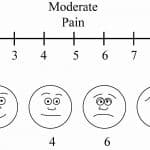Table of Contents
What is pain?

Pain (generalized) is a signal in the nervous system indicating something is wrong. It is an unpleasant feeling (prick, tingle, sting, burn, or ache). It may be sharp, dull, occasional, frequent, or constant. You may feel it in one area of your body (back, abdomen, chest, pelvis, or all over).
It can be helpful in diagnosing a problem. If you never felt it, you might seriously hurt yourself without knowing it, or you might not realize you have a medical problem that needs treatment.
How bad is my pain?
Your clinic team will use this scale (see figure on right
Mild: Pain score of 3 or less on the VAS scale. This pain should not stop you from doing activities of daily life (like grocery shopping, laundry, cooking).

Moderate: Pain score of 4 to 6. This pain stops you from doing instrumental activities of daily life (preparing meals, managing money, shopping, doing housework, and using a telephone).
Severe: Pain score of 7 or higher. This pain is bad enough to stop you from even the most basic (self-care) activities of daily life like eating, dressing, getting into or out of a bed or chair, taking a bath or shower, and using the toilet.
How to manage mild pain?
Keep track of your pain levels using Ankr (myAnkr web portal or the Ankr app). It will help you describe the pain to your doctor or nurse.
Treatment depends on the underlying issue or injury.
- Over-the-counter pain relievers (acetaminophen, aspirin, or ibuprofen)
- Prescription anti-inflammatory drugs (corticosteroids or certain types of COX-2 inhibitors)
- Opioid medications
- Antidepressant or anti-seizure medications
- Physical therapy
- Occupational therapy
How to manage moderate and severe pain?
Contact your health care provider immediately if you have:
- The result of an injury or accident that may have caused substantial damage to your body, including severe or uncontrollable bleeding, broken bones, or head injury
- An acute and sharp internal pain, which may be a sign of a serious problem (ruptured appendix or bowel perforation).
- Located in your chest, back, shoulders, neck, or jaw and accompanied by other potential signs or symptoms of a heart attack (pressure in your chest, shortness of breath, dizziness, weakness, cold sweats, nausea, or vomiting).
- Interfering with your day-to-day life, including your ability to sleep, work, or take part in other activities that are important to you
What causes pain?
Some causes of acute pain
- A skinned elbow or knee
- A minor burn
- A pulled or strained muscle
- A tension headache
- Post-surgery
- A broken bone
- A minor ankle sprain
- Muscle, tendon, skin, or bone injury
- Labor and delivery
Some causes of chronic pain
- Arthritis
- Fibromyalgia
- Diabetes
- A herniated disc in the neck or back
- Cancer
- Chronic migraine headaches
- A compressed or pinched nerve
- Sciatica
- Chronic fatigue syndrome
- Heart attack
- Stroke
